 | ||
Artificial life (often abbreviated ALife or A-Life) is a field of study wherein researchers examine systems related to natural life, its processes, and its evolution, through the use of simulations with computer models, robotics, and biochemistry. The discipline was named by Christopher Langton, an American theoretical biologist, in 1986. There are three main kinds of alife, named for their approaches: soft, from software; hard, from hardware; and wet, from biochemistry. Artificial life researchers study traditional biology by trying to recreate aspects of biological phenomena.
Contents
Overview
Artificial life studies the fundamental processes of living systems in artificial environments in order to gain a deeper understanding of the complex information processing that define such systems. These topics are broad, but often include evolutionary dynamics, emergent properties of collective systems, biomimicry, as well as related issues about the philosophy of the nature of life and the use of lifelike properties in artistic works.
Philosophy
The modeling philosophy of artificial life strongly differs from traditional modeling by studying not only "life-as-we-know-it" but also "life-as-it-might-be".
A traditional model of a biological system will focus on capturing its most important parameters. In contrast, an alife modeling approach will generally seek to decipher the most simple and general principles underlying life and implement them in a simulation. The simulation then offers the possibility to analyse new and different lifelike systems.
Vladimir Georgievich Red'ko proposed to generalize this distinction to the modeling of any process, leading to the more general distinction of "processes-as-we-know-them" and "processes-as-they-could-be".
At present, the commonly accepted definition of life does not consider any current alife simulations or software to be alive, and they do not constitute part of the evolutionary process of any ecosystem. However, different opinions about artificial life's potential have arisen:
Techniques
Notable simulators
This is a list of artificial life/digital organism simulators, organized by the method of creature definition.
Program-based
Program-based simulations contain organisms with a complex DNA language, usually Turing complete. This language is more often in the form of a computer program than actual biological DNA. Assembly derivatives are the most common languages used. An organism "lives" when its code is executed, and there are usually various methods allowing self-replication. Mutations are generally implemented as random changes to the code. Use of cellular automata is common but not required. Another example could be an artificial intelligence and multi-agent system/program.
Module-based
Individual modules are added to a creature. These modules modify the creature's behaviors and characteristics either directly, by hard coding into the simulation (leg type A increases speed and metabolism), or indirectly, through the emergent interactions between a creature's modules (leg type A moves up and down with a frequency of X, which interacts with other legs to create motion). Generally these are simulators which emphasize user creation and accessibility over mutation and evolution.
Parameter-based
Organisms are generally constructed with pre-defined and fixed behaviors that are controlled by various parameters that mutate. That is, each organism contains a collection of numbers or other finite parameters. Each parameter controls one or several aspects of an organism in a well-defined way.
Neural net–based
These simulations have creatures that learn and grow using neural nets or a close derivative. Emphasis is often, although not always, more on learning than on natural selection.
Hardware-based ("hard")
Hardware-based artificial life mainly consist of robots, that is, automatically guided machines able to do tasks on their own.
Biochemical-based ("wet")
Biochemical-based life is studied in the field of synthetic biology. It involves e.g. the creation of synthetic DNA. The term "wet" is an extension of the term "wetware".
Open problems
Related subjects
- Artificial intelligence has traditionally used a top down approach, while alife generally works from the bottom up.
- Artificial chemistry started as a method within the alife community to abstract the processes of chemical reactions.
- Evolutionary algorithms are a practical application of the weak alife principle applied to optimization problems. Many optimization algorithms have been crafted which borrow from or closely mirror alife techniques. The primary difference lies in explicitly defining the fitness of an agent by its ability to solve a problem, instead of its ability to find food, reproduce, or avoid death. The following is a list of evolutionary algorithms closely related to and used in alife:
- Ant colony optimization
- Bacterial colony optimization
- Genetic algorithm
- Genetic programming
- Swarm intelligence
- Multi-agent system – A multi-agent system is a computerized system composed of multiple interacting intelligent agents within an environment.
- Evolutionary art uses techniques and methods from artificial life to create new forms of art.
- Evolutionary music uses similar techniques, but applied to music instead of visual art.
- Abiogenesis and the origin of life sometimes employ alife methodologies as well.
Criticism
Alife has had a controversial history. John Maynard Smith criticized certain artificial life work in 1994 as "fact-free science".
